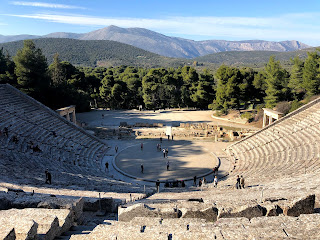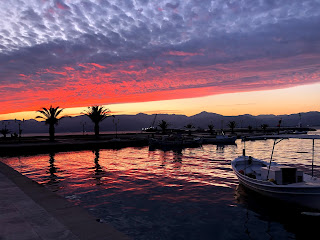Peloponnese Field Trip!! Day 1!!
Day one of our whole program Peloponnese field trip! I’m super excited about this trip. The Peloponnese played such an influential part in the shaping and identity of Ancient Greek history. As a classical studies major, I’m most excited about visiting all the sites associated with mythology!!!
We have all been split into 6 different groups with different focuses. My group’s theme is “The Shaping of Identities”. We will explore the importance and role of fortified locations in shaping and protecting the character, independence, and survival of the Peloponnese and its people.
We set off at 8am sharp from CYA and made a stop at the Isthmus of Corinth. Apparently, the word “isthmus” comes from the Ancient Greek word for “neck” and refers to the narrow strip of land that connects the Peloponnese to mainland Greece. We all stopped on the bridge to look down into the canal that cuts across the land, connecting the Gulf of Corinth with the Saronic Gulf. The canal now is an incredible sight—the land drops straight down hundreds of feet and standing on the bridge, you can see both ends of the narrow canal. It’s crazy to think that throughout ancient Greek history, so many attempts were made to dig this canal by hand.
Our next stop was the archaeological site of Mycenae where we saw the infamous Lion’s Gate and Grave Circle A where the Mask of Agamemnon was discovered. Standing at the Lion’s Gate, we got to see the fortification wall that enclosed the main portion of the city. The wall is 6 feet thick and built from huge limestone blocks fitted together. They’re called “cyclopean walls” because Ancient Greeks (after the Myceneans) believed they were built by cyclops. Something our group discussed was the purpose of the walls. They were unnecessarily thick and there is no evidence that contemporary Minoans on the island of Crete had fortifications enclosing their cities. Our conclusion was that the thickness of the walls was to send a message to other Mycenean cities of their power. We also got to go to the Epidaurus theater!! We took turns standing in the middle of the theater to test out the acoustics. A man came up and started singing opera while we were there!
 |
| The Mycenean Cyclopean Wall |
 |
| Ancient Theater of Epidaurus |
 |
| The Lion's Gate |
We also visited the archaeological site of Epidaurus. Our group leader, Professor Demetrios, led us through the sanctuary of Asclepios on the route that an Ancient Greek visitor would have taken. Before entering, a visitor would cleanse themself in order not to pollute the sanctuary. Upon entering, they would make a sacrifice to Asclepios at the temple. The sick would head to the Enkoimeterion where they would sleep and receive a dream from the god with instructions on to heal themselves. What was cool to see was that the sick weren’t the only ones to visit the sanctuary. It included sources of entertainment like a music hall, stadium, baths, and a boxing/wrestling courtyard for other visitors.
 |
| Apparently, the! best! gelato! |
We spent the night in the beautiful port town of Nafplio, the first capital of the independent Greek state. Apparently, Nafplio has the best gelato so, of course, Professor Dimitri had to treat us all to some! Our group sat on the port and watched the sun set over the ocean. The views are breathtaking!!!!
 |
| Sunset at Nafplio! |
No comments:
Post a Comment